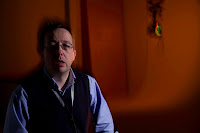With more resolve – and at a later time slot – I decided to brave the outdoors.
Firstly, I remembered two things that Dave Mann told me: the flash will freeze the person in the photo and the long exposure time will capture any ambient light. What I hadn't accounted for was:
a) lens flare – even though I had a lens hood, the sheer amount of light in the urban setting from streetlights and cars inevitably causes flare
b) speckling – some of the pictures were destroyed by a speckling effect from the light, which appears on the image as missing pixels and is very hard to repair and
c) the inevitable motion blur – Some of the pictures were ruined by the long exposure time. It was cold and windy, I can imagine I was probably shivering, which has translated onto the image as motion blur
The camera also took a while to process the image after taking the shot, making continuous shooting fairly difficult.
However, it wasn't a total loss:
 |
| Miss America In Suburbia 1 |
The most annoying thing about motion blur is that the clarity of the expression was lost:
 |
| Miss America In Suburbia 2 |
The best shot of the night also used this ghosting effect:
 |
| Miss America In Suburbia 3 |
I think I also need a more effective way of monitoring how the shots are going 'on-site' as taking photos of yourself, reviewing, running back can be an arduous process. This is easier with tethering in the studio as you can instantly see it on the computer, but I'm wondering if there is a camera with a larger display, for example, that would help me see how the shots are turning out 'as I go'.
On the whole, I'm glad I got this one out of my system. It didn't turn out quite how I wanted it to – I wanted to emphasise the hysteria and isolation of this Miss America figure. Several things could be done to help this. Taking someone out with me might be a massive confidence boost for a start. Also it might be worth considering doing this as a daytime shoot to see the contrast between night and day light, and whether it adds/detracts. Additionally I'm quite satisfied with the capturing of the ambient light as I think the exposure of the pictures was actually very good and well balanced in contrast with the flash.











